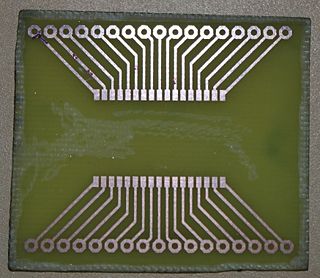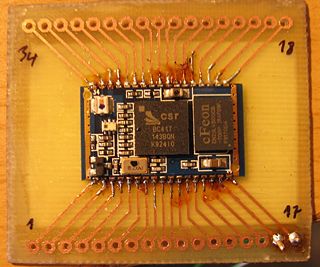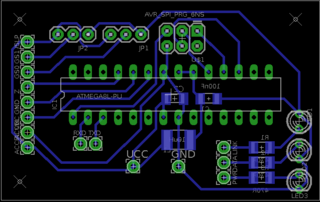Difference between revisions of "Accelerometer data over bluetooth"
| Line 25: | Line 25: | ||
As you can see, i chosed the Atmega8 microprocessor. The reason was that i was playing a little bit with it before starting bachelors project, so i used my little base knowledge i already gained ;) What the Atmega does is that it reads and converts axes from accelerometer and send then over UART into bluetooth module. | As you can see, i chosed the Atmega8 microprocessor. The reason was that i was playing a little bit with it before starting bachelors project, so i used my little base knowledge i already gained ;) What the Atmega does is that it reads and converts axes from accelerometer and send then over UART into bluetooth module. | ||
| − | [[Image: | + | |
| + | [[Image:UPscho.png|320px|Schematics of microcontroler board.]] | ||
| + | [[Image:UPbrd.png|320px|Microcontroler board.]] | ||
== Schematics - Power supply board == | == Schematics - Power supply board == | ||
Revision as of 13:35, 18 March 2010
Contents
Introduction
The story begins in one nice suny morning when i came across project where the guy took a glove from some old nintendo console and remade it with accelerometer and bluetooth module. I watched his youtube movie without even breathing. A few months later came the time when it was necessary to pick up a bachelors project so i can get a degree. Searching for a right topic for me i came along "Data transmission over bluetooth" topic and i said myself, "this would be great to use bachelors project to make something i want". And that's, how it began :)
Accelerometer module
Image of accelerometer module
Where to buy?
Bluetooth module
Image
Module image
Eagle library
Eagle library.
Datasheet
Datasheet.
PCB
I used only one foil with 1200dpi printed movite. I have HP LaserJet P1005 printer.



Schematic - Microcontrooller board
As you can see, i chosed the Atmega8 microprocessor. The reason was that i was playing a little bit with it before starting bachelors project, so i used my little base knowledge i already gained ;) What the Atmega does is that it reads and converts axes from accelerometer and send then over UART into bluetooth module.
Schematics of microcontroler board.

Schematics - Power supply board
I'm actually useing IO LP2951CM which is is low power, low dropout voltage, voltage regulator, handy for battery powered applications. I'm using this one as power supply for mictrocontroller, BT module and Accelerometer and voltage reference for ADC of uP.
Parts
Accelerometer Motorola/Freescale MMA7260Q
Microprocessor Atmel Atmega8
BT module Rayson BTM-112
Movie
<youtube width="330" height="220" align="left">YZGwKe6Cvhw</youtube>
May the source be with you
As would master Yoda say: A lot of to learn i still have!
<enscript lang=c>
- define F_CPU 8000000UL
- define BAUD_RATE 19200
- include <util/delay.h>
- include <avr/io.h>
void init_adc(void) { ADCSRA = (1<<ADEN) | (0<<ADFR) | (0<<ADIE) | (1<<ADPS2) | (0<<ADPS1) | (0<<ADPS0);
ADMUX = (0<<REFS1) | (1<<REFS0) | (1<<ADLAR) | (0<<MUX3) | (0<<MUX2) | (0<<MUX1) | (0<<MUX0);
}
void init_uart(void)
{
UCSRA = (0<<RXC) | (0<<TXC) | (0<<UDRE) | (0<<FE) | (0<<DOR) | (0<<PE) | (0<<U2X) | (0<<MPCM);
UCSRB = (0<<RXCIE) | (0<<TXCIE) | (0<<UDRIE) | (0<<RXEN) | (1<<TXEN) | (0<<UCSZ2) | (0<<RXB8) | (0<<TXB8);
UCSRC = (1<<URSEL) | (0<<UMSEL) | (0<<UPM1) | (0<<UPM0) | (0<<USBS) | (1<<UCSZ1) | (1<<UCSZ0) | (0<<UCPOL);
//UBRRH = 0b00000000;
//UBRRL = 0x02;
UBRRH = (((F_CPU/BAUD_RATE)/16)-1)>>8; // set baud rate
UBRRL = (((F_CPU/BAUD_RATE)/16)-1);
}
unsigned char get_adc(unsigned char adc)
{
unsigned char value=0;
ADMUX = adc; ADCSRA |= (1<<ADSC);
while(!(ADCSRA & (1<<ADIF))) ;
value = ADCH;
ADCSRA &= ~(1<<ADIF);
return value; }
void transmit( unsigned char data )
{
while( !(UCSRA & ( 1 << UDRE ) ) )
;
UDR = data;
while (!(UCSRA & (1 << TXC ) ) ) // TXC == 0;
;
if((UCSRA & (1<<TXC))) // TXC != 0; UCSRA = (1 << TXC);
}
void decompose( unsigned char i )
{
unsigned char j;
unsigned int k = 1000;
while(i>0) { j=i/k; i -= k*j; j += 48; k /= 10; transmit(j); } }
int main(void)
{
unsigned char i; unsigned char adc=0x20; unsigned int value=0,data[10];
init_adc(); init_uart();
while(1) {
for(i=0;i<10;i++) { data[i] = get_adc(adc); }
value = 0; for(i=0;i<10;i++) value += (unsigned int) data[i]; value /= 10;
switch(adc)
{
case 0x20:
transmit('x');
transmit(':');
decompose(value);
transmit(' ');
break;
case 0x21:
transmit('y');
transmit(':');
decompose(value);
transmit(' ');
break;
case 0x22:
transmit('z');
transmit(':');
decompose(value);
transmit('\n');
break;
default: transmit('0'); break;
}
++adc;
if(adc == 0x23)
adc=0x20;
_delay_ms(30);
}
return 0;
}
</enscript>
